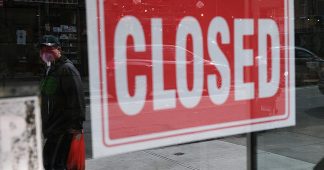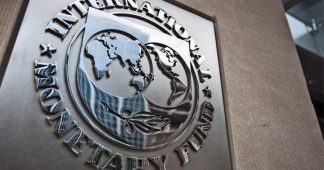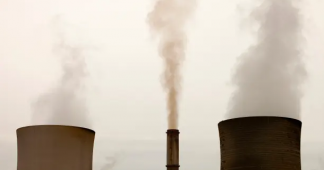By Carlo Fanelli and Heather Whiteside
July 30, 2020
“Toward the end of the twentieth century a sickness struck the world. Not everyone died, but all suffered from it” — Samir Amin (2003, 7).
It has been over forty years since Thatcher and monetarism, thirty years since the Canada-US Free trade agreement came into effect, and twenty years since the launch of the Euro. More recently, 2020 marks twelve years since the Great Recession and bank bailouts began, ten years since the turn to stimulus and sharp return to austerity, and three years since the Paris Agreement on Climate Change. These historical milestones already offered an opportunity for a retrospective with future implications; however, 2020 will undoubtedly be remembered as the year of the virus with all the attendant hardship and hope that might bring.
Circulating since late 2019 through global trade and travel connections from its epicentre in Wuhan, China, by early March 2020 the World Health Organization declared COVID-19 to be a global pandemic. Soon, some eighty countries had implemented lockdown measures to curb the spread, from restrictions on the movement of people, to commerce and border closures. Stalwarts of neoliberal governance quickly became bastions of state intervention: from stimulus and neo-mercantilism to seizing the means of production and interfering with circulation and accumulation (ILO, 2020). Proving the Marxian insight that capital is value in motion, lockdown breeds a new ill: grim forecasts for 2020-21 predict economic recession harkening back to the depths of the Great Depression (IMF, 2020). There can be no doubt that the immediate and dire emergency of the current crisis is directly related to COVID-19; its roots, however, can be traced much deeper to the contagion that struck centuries earlier: the ‘liberal virus’.
Samir Amin (2003: 9) summarizes the liberal virus in the following way: “Social effectiveness is equated by liberals with economic efficiency which, in turn, is confounded with the financial profitability of capital. These reductions express the dominance of the economic, a dominance characteristic of capitalism. The atrophied social thought derived from this dominance is ‘economistic’ in the extreme. Curiously, this reproach, wrongly directed at Marxism, in fact characterizes capitalist liberalism.” The paired opposition of social classes, fractured along crosscutting registers of social identity, provides the basis for this exploitation and propels the capitalist contagion forward (Fanelli and Noonen, 2018; Whiteside, 2020). Clarifying the underlying causes of illness, whether coronavirus or liberal virus, is not only an important diagnostic in its own right, it is also crucial for future well-being.
Profiting from Pandemic
The 2020 public health crisis is exacerbating the socio-economic disparities of liberal capitalism, pushing low waged and food insecure communities into deeper distress (Henderson, 2020). It is estimated that nearly half of the working age US population is employed in low wage jobs, with forty-four per cent of workers earning a median annual salary of $18,000, or roughly $10.22 per hour (Picchi, 2019). Juxtaposed with the anxiety, stress, concerns, and insecurity of the majority, billionaires profit from the pandemic: the impoverishment of the former and the wealth of the latter are linked economically and institutionalized politically. In less than a month, between March and April 2020, the wealth of American billionaires increased by almost 10 per cent or by $282-billion. These astonishing gains were made possible by decades of regressive tax cuts and billionaire-friendly regulations, which saw wealth surge over 1,100 per cent between 1990-2018, all the while tax obligations as a percentage of their wealth decreased by 80 per cent since the 1980s (Collins et al., 2020). Indeed, the world’s wealthiest families are estimated to get $4-million richer by the hour (Bloomberg, 2019). Estimates suggest that global loses from multinational corporations shifting their profits are worth some $600-billion per year, with cash stashed in tax havens equal to at least 10 per cent of the world economy (Shaxon, 2019).
In Canada, it is estimated that more than $240-billion is hidden in offshore tax havens, depriving the public purse of close to $15-billion per year (Dubinsky, 2018). What is more, it is estimated that the top 1 per cent of individuals, those making in excess of $200,000 annually, receive 87 per cent of the capital gains tax breaks (taxed at half the rate of regular income), resulting in a $7-billion annual redistribution from the “99%” to the “1%”. Statistics Canada found that in 2017 Canada’s top 0.1 per cent saw a 17 per cent ($740,300) increase in their average total income, outdone only by the top 0.01 per cent who saw their incomes rise 27 per cent ($2.7-million) but in stark contrast to the measly 2.5 per cent ($48,400) average increase – and the fourth-largest increase in close to four decades is set amid declining taxes for the ultra-wealthy (Blatchford, 2019). Even the resolutely conservative Financial Post (Pelletier, 2019) has declared, “Our nation of oligopolies not good for consumers, but great for investors” as a handful of companies dominate the Canadian banking, telecommunications, energy, supermarket, airline and other industries.
The OECD ranks Canada 25th out of 37, behind even the US, when it comes to public spending on social services as a share of GDP, a trend connected to the decades-long assault on public services as avenues of profit accumulation through privatization, public-private-partnerships and other forms of marketization (Evans and Fanelli, 2018; Whiteside, 2015). Business subsidies are all the while estimated to be worth some $29-billion annually; exemplified by the recent federal government write-off of $3.7-billion from the 2009 auto sector bailouts, the $5-billion pipeline purchase in 2018, and the $1.7-billion recently provided to the oil and gas industry as part of the federal government’s COVID-19 economic response to clean up capital’s mess – orphaned wells being worth an estimated $260-billion in unfunded environmental liabilities (Lukacs, 2017; CBC 2019; Harris, 2020). In Europe, investigations have been launched into the practices of European banks, Bank of America, JPMorgan Chase, Morgan Stanley and others who are accused of siphoning some $60-billion from public coffers between 2006-11 at the same time as they received hundreds of billions from taxpayer financial supports (Segal, 2020).
COVID-19 responses feature bailouts for big business and billionaires far in excess of relief efforts for vulnerable workers, those un(der)employed, ill, disabled, or elderly. For instance, the American $2.2-trillion Coronavirus Aid, Relief, and Economic Security Act (CARES Act) offers households $500 per child and $1,200 for individuals earning up to $75,000, as well as extended unemployment insurance and an additional $600 per week (transfers declining above that income threshold). If individuals owe outstanding debt, there is nothing preventing banks from garnishing that pandemic support, not to mention the labyrinthine patchwork of eligibility requirements needed to access unemployment insurance (Dickerson, 2020). Small and medium sized businesses are required to make reasonable efforts to maintain their payroll and employees, including restrictions on issuing dividends and executive compensation, but those same rules do not apply to large corporations receiving aid. CARES is, in short, an uncaring act defiant of logic and decency.
Revealing the class character of the bailout, the Federal Reserve and the Treasury Department will buy up to $750-billion in bonds issued by large corporations with no strings attached: no limits on dividends, executive compensation, stock buybacks, or employment levels. As Gibson (2020) reveals, “The richest Americans are also enjoying a tax break that Senate Republicans sneaked in. A recent analysis by the Joint Committee on Taxation found that more than 80% of the benefits of a change in the tax code for ‘pass-through’ businesses will go to Americans who make more than $1-million per year.” If past practices are the best predictor of future performance, one need look no further than Trump’s 2017 dramatic corporate tax cuts to anticipate the impact of CARES. Advocates of the 2017 tax reforms claimed wages would rise, investments would surge, and the cuts would pay for themselves. In reality, as the Congressional Research Service has shown, wages did not rise, investment did not increase, and the tax cuts did not benefit government coffers; instead they led to a record-breaking upswell in corporate stock buybacks and dividends for shareholders worth over $1-trillion, which reduced federal revenue by $170-billion by end of 2018 (Gravelle and Marples, 2019). Again, this recent episode is not only unsurprising, it is also aligned with some forty years of economic evidence (Stanford, 2011; Shefner and Blad, 2020).
Corporations are also looking to pick up assets pummeled by the virus, 2020 deflation being the friend of vulture capital just as toxic assets were through 2008 bankruptcies. A reminder of Marx’s diagnosis of capitalist patterns of concentration and centralization, once-liberal states in Europe like Germany, France, Italy, and Spain are now taking up nationalist efforts to “veto investment from outside the EU in recent weeks and the bloc is ushering in the first continent-wide rules for screening takeovers on security grounds. Special safeguards have been offered to biotech firms as the race for a vaccine against COVID-19 takes on critical importance” (Stearns, 2020). The embrace of foreign direct investment and takeovers has been decisively shuttered over a very short period. Whether or not this is a short- or long-term response remains to be seen. States nevertheless continue to bailout large corporations by the billions, with small deviations exemplified by the Danish and Polish exclusion of tax haven-incorporated firms. Canadian Prime Minister Justin Trudeau has barred companies that have been convicted of tax evasion from government support. However, with zero companies convicted to date, this decree essentially applies to no one, and thus companies registered overseas are set to receive billions in public support. The vultures continue to circle, with BlackRock, the world’s largest asset manager (responsible for $27-trillion), now leading the Federal Reserve’s corporate debt purchasing program worth some $4.5-trillion and thoroughly integrated into the Canada Infrastructure Bank (McQuaig, 2019; Nelson, 2020).
Billionaires may not have caused the pandemic but the public policies enabling their wealth accumulation strategies have exacerbated the collateral damage, with foregone tax revenues and public investments, extreme inequality, poverty and precarity of job tenure precipitating the pandemic and shaping the likely outcomes of current support measures. The COVID-19 era is thus a crisis of unprecedented proportions not only for its effects on production and reproduction, but through the coalescing of structural inequalities and cyclical instabilities equally characteristic of capitalism. State responses have been predictably handcuffed by its mode of production and status quo delimitation of future possibilities, making economic overhaul all the more urgent.
Pushing Past the Capitalist Pandemic
COVID-19 began as a health emergency but having emerged in the context of political-economic illness, it soon brought into sharp focus the significance of public services. Researchers at the Canadian Centre for Policy Alternatives estimated in 2009 that average Canadians received an amount equal to $17,000 from public services (Shillington and Mackenzie, 2009). For some two-thirds of the Canadian population, the social wage – public services or benefits that supplement market income – made up more than half of household income. For Canadians in median income households, this amounted to $41,000 worth of public services like healthcare, education, and personal transfer payments (see also: Statistics Canada 2019).
Contrary to the assertions of the most hardened ideologues, most people receive far more value from universal public services than that they pay in taxes. Public services also reduce broader inequalities, particularly in times of economic difficultly or labour market uncertainty, and ensure that ordinary people can have a say in the quality and cost of those services. Even so, this has not stopped a cacophony of “pedantic, leather-tongued oracles of the ordinary bourgeoisie” (Marx, 1867) from coming out of the woodwork in the midst of the 2020 pandemic to fan the flames of deficit hysteria; without a hint of shame, calling for reductions, or the outright elimination, of the very public services and jobs that have buttressed the most severe effects of the COVID-19 crisis (Cross, 2020; Ivison, 2020). Vampire-like ideology is, however, hard to kill, even if it means that “an entire generation has been thrown on the scrap heap in the name of ‘balancing the books’” (Coppola, 2018; cf. Cohen 1997).
As others have noted, the deficit per se is less important than the debt servicing costs associated with it, and what that debt is incurred for matters, particularly when making much-needed investments in public services to restore economic growth or address protracted periods of unemployment. The affordability of public debt is an issue for the denominator: the debt-to-GDP ratio. In the context of rock bottom interest rates, debt-servicing burdens drop relative to the overall size of the economy when growth occurs. Far from radical, these are the findings of neoliberalism’s longtime architect-in-chief, the IMF (Barrett, 2018), and are the plain implications of the widely debunked fiscal consolidation thesis (Herndon et al., 2013). Exposed as the vulgar charlatans that they are, proponents of neoliberalism and austerity are out of ideas; indeed, if they were really serious about the deficit, they need not look any further than the tens of trillions doled for corporate welfare and tax cuts for the wealthy.
China, as coronavirus epicenter, hampered global supply to/from the ‘workshop of the world’, with shortages of ventilators, medical supplies, and personal protective equipment a painful reminder that domestic manufacturing capacity matters. The post-Confederation Canadian economy, embedded in settler-colonial dispossession, was created by National Policy protective domestic tariffs for infant industry and state support (through ownership and investment) for transportation, energy, manufacturing, and services. Not just an antique feature of Canada’s origins, the period preceding the 1980s saw restrictions on unfettered foreign direct investment for fear that this would undermine national sovereignty, self-sufficiency and the democratic capacity to enact policies in the public interest. Foreign ownership of key industries declined, high value-added production increased, along with real wages and unionization. “Far from being a tool employed exclusively by Canada’s economic and political elites,” High (2003, 169) contends “the new nationalism became a powerful rhetorical weapon in the hands of working people to be used against companies that closed plants.” However, the situation changed profoundly over the next twenty years.
As Jim Stanford has shown (2019), Canada was reoriented toward the export of raw materials – agriculture, forestry, minerals, and energy. A good many trade sensitive industries were also damaged through sharp currency appreciation, contributing to stagnant productivity and innovation gains, and undermining the development of a sustainable and diversified economy able to weather volatile global commodities markets. Canada was not alone, many other countries too having undergone a period of protracted ‘deindustrialization’ as governments facilitated the offshoring of manufacturing capacity to low-wage jurisdictions, often those with lax environmental protections and authoritarian regimes (Ness, 2017). COVID-19 prompted emergency legislation (Bill C-13) granting the Canadian government the power to authorize any manufacturer to make patented medicines during a public health emergency. However, as Nathaniel Lipkis (2020) has written, it may be too little, too late given the loss of domestic capacity.
Initiatives such as these have led some to conclude that, “the era of peak globalisation is over. An economic system that relied on worldwide production and long supply chains is morphing into one that will be less interconnected” (Gray, 2020). Indeed, principal responses to the pandemic have been primarily national and sub-national, with attention now turning to national recovery strategies. Others remain less convinced, “[T]he world following the pandemic is unlikely to be radically different from the one that preceded it,” writes Haass (2020).
What the world economy will look like a year from now, let alone ten or twenty, may be uncertain, but there is little denying that governments will have the difficult tasks of both ramping up spending to rebuild the economy and generating revenue needed to cover the emergency outlays. Time and again, the private sector (whether competitive or monopolistic) has shown itself to be not only disinterested in wholesale systemic coordination, but also incapable of it. The private sector has equally hindered government intervention or funnelled it into meeting narrow interests (Mazzucato, 2013).
A pious fidelity to upholding the same policies that got us into this mess will not be able to reverse its course. Any substantive reform agenda will need to begin with the recognition that recovery begins at home, in the spheres of production and social reproduction, centred on the waged, unwaged, and those denied the chance to earn a wage when their skills are deemed unproductive or inferior. A companion to this is the recognition that the climate crisis is the “greatest challenge of our time” (Fanelli, 2013). Almost daily, we are reminded that the wellbeing of the natural world is also stricken with disease – capitalist-fostered human impacts worsening more quickly than the models predicted, from global temperature increases to melting ice sheets, retreat of glaciers, rising and acidifying oceans, deforestation, displacement, shifts in weather patterns, food chains, plant and animal life, water shortages and massive species extinctions (Monbiot, 2018; Milman, 2019; Carrington, 2019; Plumer, 2019; Ahmed, 2019).
It is the ‘unrealistic’ proposals that are increasingly the only ones standing a chance of making a realistic difference. Ending climate change requires the end of capitalism as we know it: “Any meaningful policy has to upset the established power base and the political donor class. Any policy that doesn’t upset these people will be useless. To pretend that we can compromise our way through this while we wait for a magical, technological bullet that will keep temperatures down without costing us anything is beyond wilful ignorance now” (McDuff, 2019). This is a contradiction Keynesianism and social democracy are powerless to overcome (Evans and Schmidt, 2012; Fanelli, 2015; Schmidt, 2018). If historians of the future are to look back upon the COVID-19 pandemic as a truly transformative political and economic turning point, alternate routes are necessary.
The Financial Times (2020) felt compelled to reason that, “Radical reforms – reversing the prevailing policy direction of the last four decades – will need to be put on the table. They must see public services as investments rather than liabilities, and look for ways to make labour markets less secure. Redistribution will again be on the agenda; the privileges of the elderly and wealthy in question. Policies until recently considered eccentric, such as basic income and wealth taxes, will have to be in the mix.” That the Financial Times lists as ‘radical’ the protection of public services, creation of less insecure labour markets, provision of a basic income, and implementation of wealth taxes indicates not only the limit of its vision but also how ripe the moment is for change.
Real change begins with challenging the structural power of capital shaping production and social reproduction; not limiting ourselves to timid redistribution but taking on hard questions like what happens pre-distribution through state power and how distribution is determined through property rights. Even the IMF (2019; 2020) recently proposed ramping up income, property and wealth taxes, modeled as a “solidarity surcharge,” noting that profit shifting by multinational corporations in tax havens undermines both public revenue and faith in the fairness of the tax system. And the Parliamentary Budget Officer of Canada recently estimated that a 1 per cent tax on those with a net worth of $20-million or more could generate upwards of $70-billion over the next decade (PBO, 2019).
Of course, public policies matter, including the form of state interventions to support value-added activity, such as requirements for domestic processing, limits on exports of unrefined resources, the use of fiscal subsidies to encourage downstream, investments and the direct allocation of public equity capital in large-scale resource projects. Canadian economic history, not to mention the recent experiences of many Latin American and Asian economies, has relied on state planning, subsidized capital, strong domestic supply networks and innovation clusters, effective export promotion, and effective limits on imports to nurture high value-added export industries. Going further, this could also include, contrary to the contemporary emphasis on laissez-faire, proactive policies mandating domestic reinvestment and domestic content quotas in strategic sectors, active trade interventions, and public ownership.
With governments increasingly detached from the demands of ordinary people and hostile toward tripartite compromises with labour, public involvement in formal politics has declined significantly (McBride and Whiteside, 2011). For Pilon (2018), this has led to both an increased public disdain for and seeming indifference to politics, which is indicative of a broader crisis with deeper roots – namely, that western electoral democracies are not, and never have been, wholly democratic to begin with. In the absence of substantive alternatives, mounting inequality and social polarization have led to a resurgence of populist, anti-establishment parties.
The ‘fanatical centre’ (Krugman, 2019), a politics devoid of adversaries, is an increasingly spent force neither able to provide a convincing intellectual explanation nor connect with the various layers of the working class negatively affected by the consequences of neoliberal de-democratization (Albo and Fanelli, 2014; Crouch, 2011). However, the left increasingly finds itself at an impasse too, having not only yielded the language of social change to the right but also seemingly unable to seize the appetite for transformative change. Indeed, the politics of political discourse have been historically tied to changing dynamics between governing elites and the masses around the world. Marx famously noted that history repeats itself first as tragedy and second as farce. For the left, the recurring ability of neoliberalism to reinvent itself has been clearly and consistently tragic. The decade of austerity that has followed in the wake of the Great Recession reveals how constituted state powers remain political obstacles requiring strategic address, not theoretical abstractions. This is why, in our view, it is mistaken to juxtapose national struggles with transnational activism. If an emancipatory politics of resistance is to emerge, it will do so from multiple scales through a national politics of transformation that is internationalist in its commitments. In other words, local bases of power need to be integrated into revolutionary projects to transform national state power and to internationalize political struggles and alliances against the world capitalist market (Albo and Fanelli, 2019).
Conclusion
“Now this liberal virus, which pollutes contemporary social thought and eliminates the capacity to understand the world, let alone to transform it, has profoundly penetrated the whole of the ‘historical left’ formed in the aftermath of the Second World War” (Samir Amin, 2003, 41).
Inoculating against the scourge of both well meaning (liberal) centrists and the rabid (racist) right will not be easy, but it is clear that the neoliberal market-led order offers nothing helpful. Crises of global proportions are forcing government intervention on an unprecedented scale – first to rescue finance in 2008, now production and reproduction in 2020. Unlike the problems experienced with social democracy and earlier variants of left nationalism, numerous polls conducted over the last decade indicate a growing interest in socialism, particularly younger adults with less to lose and much to gain. Openly socialist candidates in the US like Bernie Sanders, Ksharma Sawant, Alexandria Ocasio-Cortez and Rashida Tlaib, Jeremy Corbyn in the UK, and Pablo Iglesias in Spain are starting to win elections, challenge the right, and shift centrist policy discourse. More broadly, calls to deeply transform, if not end, capitalism now make frequent mention in mainstream media. Just a decade ago socialism was a dirty word, today it not only offers an anti-capitalist future, it is also breathing new life into the political-economic arena by offering solutions to a dire pandemic and looming ecological collapse – and healthy lives and livelihoods are just what we need right now the most. As we deal with the immediacy of the coronavirus crisis, developing a treatment for the liberal virus will be part and parcel of any long-lasting and substantive changes. •
This is an abridged and edited version of “COVID-19, Capitalism and Contagion” in the 2020 issue of Alternate Routes: A Journal of Critical Social Research.
References
- Albo, G. and C. Fanelli. (2014). Austerity Against Democracy: An Authoritarian Phase of Neoliberalism? Teoria Politica: An International Journal of Theory and Politics, 65-88.
- Amin, S. (2003). The Liberal Virus: Permanent War and the Americanization of the World. New York: Monthly Review Press.
- Barrett, P. (2018 April 6). Interest-Growth Differentials and Debt Limits in Advanced Economies. IMF working Papers.
- Blatchford, A. (2019 September 25). Canada’s richest 1 per cent enjoyed fastest income growth in 2017. Globe and Mail.
- Bloomberg. (2019 August 10). The World’s Wealthiest Family Gets $4 Million Richer Every Hour.
- Carrington, D.P. (2019 February 10). Plummeting insect numbers ‘threaten collapse of nature’. The Guardian.
- Cohen, M.G. (1997). From the Welfare State to Vampire Capitalism. In Wekerle, G., and P. Evans, eds. Women and the Canadian Welfare State (pp. 28-67). Toronto: University of Toronto Press.
- Collins, C., O. Ocampo and S. Paslaski (2020). Billionaire Bonanza: Wealth Windfalls, Tumbling Taxes and Pandemic Profiteers. Jamaica Plain, MA: Institute for Policy Studies.
- Coppola, F. (2018 April 17). Everything You’ve Been Told About Government Debt Is Wrong. Forbes.
- Cross, P. (2020 April 9). A modest proposal on public service pay to help tackle the ballooning deficit. Financial Post.
- Crouch, C. (2011). The Strange Non-Death of Neoliberalism. London: Polity.
- Dickerson, C. (2020 April 9). These Groups are Giving Out Unemployment Advice. Their Expertise? Person Experience. New York Times.
- Dubinsky, Z. (2018, June 28). Wealthy Canadians hiding up to $240B abroad, CRA says. CBC News.
- Evans, B. and C. Fanelli, eds. (2018). The Public Sector in an Era of Austerity: Perspectives from Canada’s Provinces and Territories. Montreal and Kingston: McGill-Queens University Press.
- Evans, B. and I. Schmidt. (2012). Social Democracy After the Cold War. Edmonton, AB: Athabasca University Press.
- Fanelli, C. (2013). Climate Change: ‘The Greatest Challenge of Our Time’. Alternate Routes, 25, 15-32.
- Fanelli, C. (2015). The ‘Radical’ Keynes: An Appraisal. Workplace, 25, 69-81.
- Fanelli, C. and J. Noonan. (2018). Capital and Labour. In Schmidt, I. and C. Fanelli, eds. Reading Capital Today: Marx After 150 Years (pp. 138-159). London: Pluto Press.
- Gibson, C. (2020 April 15). Workers Are Getting the Short End of the Stick from the Cares Act. Barons.
- Gravelle, J.G. and D.J. Marples. (2019). The Economic Effects of the 2017 Tax
- Gray, J. (2020 April 1). Why this Crisis is a Turning Point in History. New Statesman.
- Haass, R. (2020 April 7). The Pandemic Will Accelerate History Rather Than Reshape It. Foreign Affairs.
- Henderson, S. (2020 April 29). Food crisis and socioeconomic impacts of COVID-19 in the hungriest countries. Medical and Life Sciences News.
- Herndon, T., M. Ash, and R. Pollin. (2013). Does High Public Debt Consistently Stifle Economic Growth? A Critique of Reinhart and Rogoff. University of Massachusetts, Political Economy Research Institute.
- High, S. (2003). Industrial Sunset: The Making of North America’s Rust Belt, 1969-1984. Toronto: University of Toronto Press.
- ILO. (2020 May 8). Country policy responses.
- IMF. (2020 April 14). The Great Lockdown: Worst Economic Downturn Since the Great Depression.
- Ivison, J. (2020 April 28). Trudeau’s lavish handouts risk turning workers into welfare slackers. National Post.
- Kramer, M. (2020 April 9). The eurozone is at risk of a debt crisis worse than the last one. Financial Times.
- Krugman, P. (2019 January 31). Attack of the Fanatical Centrists. New York Times.
- Lapavitsas, C. (2018 October 24). Socialism starts at home. Red Pepper.
- Lipkus, N. (2020 April 10). Canadian access to coronavirus treatment is threatened by weak manufacturing capacity. Globe and Mail.
- Long, H. (2017 August 24). Half the jobs in America pay less than $18 an hour. Can Trump help? Washington Post.
- Mackenzie, H. and R. Shillington. (2009). Canada’s Quiet Bargain: The Benefits of Public Spending. Ottawa: CCPA.
- Marx, K. (1867). Capital: Volume 1.
- Mazzucato, M. (2018). The Entrepreneurial State. New York: Penguin.
- McBride, S. and Whiteside, H. 2011. Private Affluence, Public Austerity. Halifax: Fernwood.
- McDuff, P. (2019 March 18). Ending climate change requires the end of capitalism. Have we got the stomach for it? The Guardian.
- McQuaig, L. (2019). The Sport and Prey of Capitalists. Toronto: Dundurn.
- Milman, O. (2019 January 22). Greenland’s ice melting faster than scientists previously thought – study. The Guardian.
- Monbiot, G. (2018 November 4). The Earth is in a death spiral. It will take radical action to save us. The Guardian.
- Nelson, J. (2020 April 8). Blackrock Takes Command. Counterpunch.
- Ness, I. (2017). Southern Insurgency. London: Pluto Press.
- Parliamentary Budget Office of Canada. (2019). Cost Estimate of Election Campaign Proposal.
- Picchi, A. (2019 December 2). Almost half of all Americans work in low-wage jobs. CBS News.
- Pilon, D. (2018). The Struggle over Actually Existing Democracy. Socialist Register, 54, 1-27.
- Plumer, B. (2019 May 6). Humans Are Speeding Extinction and Altering the Natural World at an ‘Unprecedented’ Pace. New York Times.
- Revision: Preliminary Observations. Washington, DC: Congressional Research Service
- Segal, D. (2020 January 23). It May Be the Biggest Tax Heist Ever. And Europe Wants Justice. New York Times.
- Shaxon, N. (2019). Tackling Tax Havens. IMF.
- Stanford, J. (2011). Having Their Cake and Eating It Too: Business Profits, Taxes, and Investment in Canada: 1961 Through 2010. Ottawa: CCPA.
- Stanford, J. (2019). Staples Dependence Renewed and Betrayed: Canada’s Twenty-First Century Boom and Bust. In Thomas, M., L. Vosko, C. Fanelli and O. Lyubchencko, eds., Change and Continuity: Canadian Political Economy in the New Millennium. Montreal and Kingston: McGill-Queens University Press.
- Statistics Canada. (2019). Household actual final consumption.
- Stearns, J. (2020 April 30). Fear of Chinese and U.S. Buyers Forces Europe Onto Defensive. Bloomberg.
- Whiteside, H. (2015). Purchase for Profit. Toronto: University of Toronto Press.











